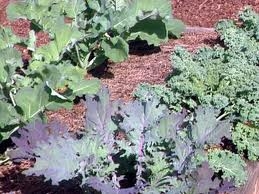
Raw kale salads with lemon and olive oil or with peanut and ginger dressing are making appearances on restaurant menus. Baked kale chips are a hit with kids. And more cooks than ever before are looking to kale for their winter vitamins.
Kale is a member of the large Brassica oleracea species. Cousins include collards, cauliflower, Brussels sprouts and broccoli. All are commonly referred to as cole crops, from the Latin word caulis, meaning stem or stalk.
Now is a great time to shop for kale seedlings at your local nursery or garden center. More varieties are being offered than ever before as interest and appreciation for this versatile vegetable grows.
Choices include Tuscan kale (also called lacinato, dinosaur kale or black palm) with its bumpy, black-green leaves; ‘Redbor,’ with its frilly purple-red leaves; and Siberian kale, with bright green, smooth leaves. All kales are rich sources of calcium, potassium and Vitamin C. History tells us that kales and wild cabbages have been foraged, cultivated and eaten throughout Europe for more than 3,000 years.
Tuscan kale adds a dramatic component to edible landscapes and is the preferred type for Italian cooking. Its leaves are up to ten inches long and two to three inches wide. As you harvest the leaves from the bottom, the plant gets taller and taller.
‘Redbor’ kale’s gorgeous magenta leaves make a stunning backdrop to orange winter calendulas. Try growing beautiful deep-pink flowering kales in front of a trellis of ‘Old Spice’ sweet peas.
If you prefer your vegetables to be green, consider Siberian kales, which are a little more like collards. ‘Winterbor’ is a deep frilled green and is both beautiful and useful in the kitchen.
Most kales are extremely winter hardy. While kales produce year round in our climate, the first light frost will bring out their sweetness as the leaf cells develop carbohydrates to buffer the plants from the cold. Harvest outer leaves from the bottom up; avoid picking the inner leaves which protect the growing point. Territorial Seed Company recommends washing and then cooling your kale harvest quickly. Keep refrigerated in a plastic bag to maintain freshness.
Kale thrives in well-dug, humus-rich soil with neutral to slightly acidic pH. Cold weather does slow the action of soil microbes, so you might need to add a complete organic fertilizer and some bone meal to your beds when you plant winter crops, just to give the microbes a boost. Always read fertilizer labels and apply as directed.
Vegetables in this family are occasionally subject to aphids. Immediately after planting, cover your crops or seed bed with Reemay or other row cover cloth to keep aphids from getting a hold. If you do discover aphids, you can usually control them with a hard spray of water. Winter crops are not typically as prone to aphid infestations as spring and summer crops are.
If you see little moths fluttering above your kale or other cole crops, look closely for cabbage looper, the larva stage of these moths. Loopers and other worms can eat your crops from the bottom up. Call the Master Gardener Help Desk (see below) for help in identifying and solving the problem.
Baby kale leaves can be harvested as soon as 25 days after planting, although cold temperatures can slow germination. Toss the baby leaves into fresh salads. Larger leaves can be steamed, braised, grilled, used as wrappers, stuffed, roasted and added to soups and stews. Harvested young, tender kale leaves can add color, texture and extra nutrients to winter meals. Seed can be sown successively throughout most of our mild winter.
My daughters taught me their favorite summer camp salad: Wash and dry the kale leaves. Remove the large central rib, then tear the leaves into bite-size pieces or shred. Squeeze fresh lemon juice onto the leaves, and rub the juice into the leaves with your hands until the leaves are wilted and soft. Finish with a drizzle of good olive oil and salt to taste. For other ideas for preparing kale, check www.epicurious.com. The site has 176 recipes for kale.
Open garden: Napa County Master Gardeners welcome the public to visit their demonstration garden at Connolly Ranch on Thursday mornings, from 10:30 a.m. until noon, except the last Thursday of the month. Connolly Ranch is at 3141 Browns Valley Road at Thompson Avenue in Napa. Enter on Thompson Avenue.
Workshop: Join Napa County Master Gardeners for a workshop on “Indoor Gardening” on Saturday, November 9, from 9:30 a.m. to 11:30 a.m. Transform a room into a vibrant living space with houseplants. Learn how to use color, texture and pattern for design and how to care for houseplants. The workshop will be held at the Senior Multi-Use Center, 2185 Elliott Drive, American Canyon. Online registration (credit card only) Mail in registration (cash or check).
Master Gardeners are volunteers who help the University of California reach the gardening public with home gardening information. Napa County Master Gardeners ( http://ucanr.org/ucmgnapa/) are available to answer gardening questions in person or by phone, Monday, Wednesday and Friday, 9 a.m. to Noon, at the U. C. Cooperative Extension office, 1710 Soscol Avenue, Suite 4, Napa, 707-253-4143, or from outside City of Napa toll-free at 877-279-3065. Or e-mail your garden questions by following the guidelines on our web site. Click on Napa, then on Have Garden Questions? Find us on Facebook under UC Master Gardeners of Napa County.